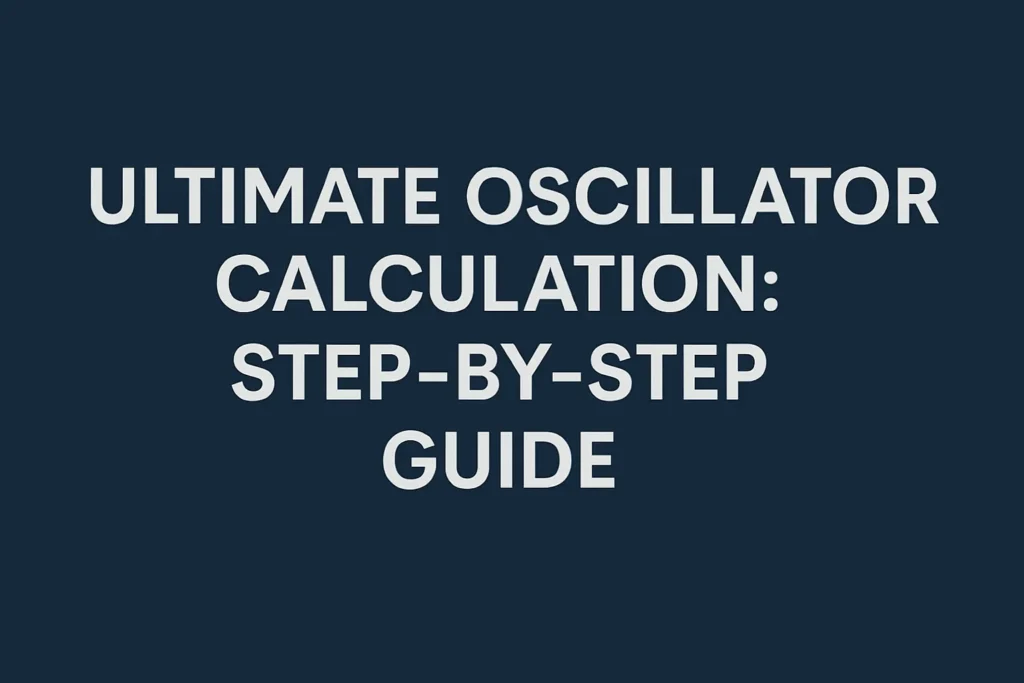The Ultimate Oscillator is a powerful momentum tool — but understanding how it’s calculated gives you an extra edge when using it for trading.
This guide will walk you through the full Ultimate Oscillator calculation, step-by-step, in a simple, beginner-friendly way.
✅ No complex math degree required!
✅ Clear breakdown of each part of the formula.
Let’s dive in.
🧠 What Is the Ultimate Oscillator Measuring?
The Ultimate Oscillator measures buying pressure compared to true range across multiple timeframes.
It answers the key question:
“Is there real, strong momentum pushing the price?”
📈 Step-by-Step Ultimate Oscillator Calculation
Here’s the simple 5-step process:
🔵 Step 1: Calculate Buying Pressure (BP)
Buying Pressure (BP) =
Today’s Closing Price – Minimum (Today’s Low or Previous Close)
✅ It measures how strongly buyers are pushing price up.
Example:
- Close: $102
- Low: $99
- Previous Close: $100
- Minimum (99, 100) = 99
- BP = 102 – 99 = 3
🔵 Step 2: Calculate True Range (TR)
True Range (TR) =
The greatest of:
- Today’s High – Today’s Low
- Absolute value of Today’s High – Yesterday’s Close
- Absolute value of Yesterday’s Close – Today’s Low
✅ It measures total daily volatility.
Example:
- High: $105
- Low: $99
- Previous Close: $100
- Values: (105-99)=6, (105-100)=5, (100-99)=1
- TR = 6
🔵 Step 3: Average BP and TR Over 3 Periods
Now, calculate the averages of Buying Pressure and True Range across:
- Short-term: 7 periods (BP7, TR7)
- Medium-term: 14 periods (BP14, TR14)
- Long-term: 28 periods (BP28, TR28)
✅ You are smoothing out short, medium, and longer price moves.
🔵 Step 4: Apply Weighted Averages
The Ultimate Oscillator formula gives more importance to short-term momentum:
plaintextCopyEditUO = [(4 × (BP7 / TR7)) + (2 × (BP14 / TR14)) + (1 × (BP28 / TR28))] ÷ (4 + 2 + 1) × 100
✅ Weights:
- Short-term: 4x
- Medium-term: 2x
- Long-term: 1x
✅ Then, divide by 7 (total weight) and scale to a 0–100 range.
🔵 Step 5: Interpret the Ultimate Oscillator Value
After calculation:
- Above 70 → Overbought (possible sell setup)
- Below 30 → Oversold (possible buy setup)
- Crossing 50 → Trend momentum shifting
🎯 Quick Ultimate Oscillator Formula Summary
| Component | Purpose |
|---|---|
| Buying Pressure (BP) | Measures upward price movement strength |
| True Range (TR) | Measures total daily volatility |
| 3-period averages | Smooth short, medium, long-term moves |
| Weighted averaging (4-2-1) | Prioritize fresh momentum |
| Final scaling (×100) | Normalize to 0–100 for easier reading |
🛠️ Practical Example (Simple Numbers)
| Period | Close | Low | High | Prev Close | BP | TR |
|---|---|---|---|---|---|---|
| Day 1 | 100 | 98 | 102 | — | — | — |
| Day 2 | 102 | 99 | 104 | 100 | 3 | 6 |
| Day 3 | 103 | 101 | 105 | 102 | 2 | 4 |
| … | … | … | … | … | … | … |
- Average BP7, BP14, BP28: Simple moving averages over respective periods.
- Average TR7, TR14, TR28: Same method.
- Plug into UO formula to get final value.
✅ That’s how the Ultimate Oscillator value appears on your chart!
🔥 Why Understanding the Calculation Helps You Trade Better
✅ You know why signals occur, not just when.
✅ You understand why divergence setups are stronger.
✅ You realize why UO is less noisy compared to simple RSI/Stochastic.
Knowledge = More powerful, confident trading.
✅ Final Thoughts
The Ultimate Oscillator combines buying pressure and volatility across three timeframes with smart weighting to deliver accurate momentum readings.
Understanding the step-by-step calculation process makes you a smarter, more strategic trader.
✅ Next time you see the UO flipping around 30, 50, or 70 — you’ll know exactly what’s happening behind the scenes!
✅ FAQs: Ultimate Oscillator Calculation
1. Why use 7, 14, and 28 periods?
They represent short, medium, and long-term momentum, offering a more complete market picture.
2. Why weight short-term data more heavily?
Because recent momentum is usually the most important for fast trading decisions.
3. Does the Ultimate Oscillator lag behind price?
A little — but much less than single timeframe oscillators thanks to its weighted design.
4. Can I customize the periods?
Yes! You can adjust to 5-10-20 for faster signals, especially on volatile stocks or crypto.
5. Does UO repaint?
No. Once a candle closes, the Ultimate Oscillator reading is fixed.
📈 Internal Linking Suggestions:
When you post this, link to:
- How the Ultimate Oscillator Formula Works (Simple Explanation)
- Ultimate Oscillator Trading Strategies That Actually Work
- How to Use Ultimate Oscillator for Spotting Reversals

